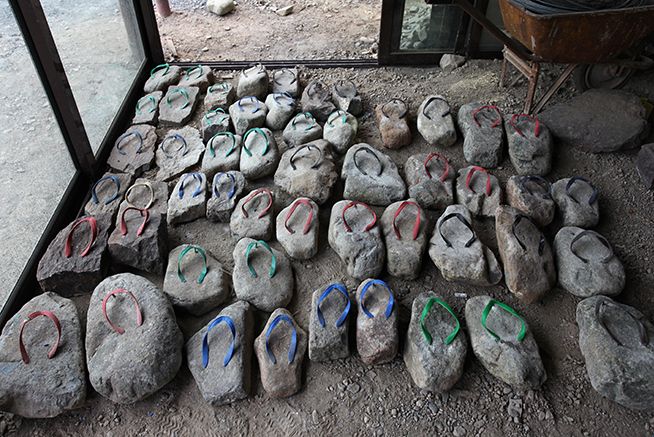
Stone Slippers (Al Zannoba), 2013
Abdullah Al Saadi
Stone Slippers (Al Zannoba), 2013
Installation
Mixed media
Courtesy of the artist
search


Abdullah Al Saadi
Stone Slippers (Al Zannoba), 2013
Installation
Mixed media
Courtesy of the artist
Sharjah Art Foundation (SAF) presents three solo exhibitions of works by Emirati artist Abdullah Al Saadi, Saudi artist Ahmed Mater and Dagestani artist Eduard Puterbrot. The openings of the exhibitions titled Abdullah Al Saadi: Al-Toubay, Ahmed Mater: 100 Found Objects and Eduard Puterbrot: Between my East and my West will take place, in the presence of HE Sheikha Hoor Al-Qasimi, President and Director of Sharjah Art Foundation at SAF Art Spaces in Al Mureijah, Sharjah Heritage Area at 6pm on 22 February, 2014. Open to the public until 22 May, 2014, works on view include paintings, installations, videos and photographs which explore wider issues of social, cultural and personal concerns that document the landscapes within which the artists live.
Abdullah Al Saadi: Al-Toubay focuses on a selection of works from Abdullah Al Saadi’s long history as an artist, and his love and fascination for nature is evident through his artistic practise. Some of these projects, which he has just completed were works in progress, and companionship is at the very centre of his long journey and has contributed to this exhibition in many ways. From his donkey in Camar Cande’s Journey (2010-2011), to the animals in The Comparative Journey (2013), to his mother in My Mother’s Letters (1998-2013) and son in The Watermelon Series (2013) each of these companions has had a profound influence on these projects. His more fantastical works, like The Comparative Journey(2013) explore how the need for companionship can even lead to relationships with inanimate objects, such as stones, which represent the various animals that later became companions on yet another journey. The hardships of these travels reflected in the Stone Slippers (2013) and the diaristic accounts and drawings reflect the life of a gypsy or nomad continuously travelling and searching for something. Al Saadi has previously exhibited his work in Sharjah Biennial 8 and Sharjah Biennial 10.
Ahmed Mater: 100 Found Objects includes images, videos and research material that Ahmed Mater has collected which chronicle Makkah’s past to its present identity. Throughout his research, Mater has gathered a rich archive of conversations. These include personal references and continuous recordings of the urban developments and expansion of Makkah, some of which are presented in this exhibition. This unique archive draws on wider political and familiar histories of communities that once lived in Makkah’s vicinity. Along with distinctive pilgrims' tales, both the intimacy and the anonymity implicit in mass congregations of peoples from all over the world is revealed. We are taken on a passage that encompasses individual recollections of broad social and political events. Personal and collective dreams and ideologies are reflected through symbolism associated with a site that draws on the visions of every man, woman and child interconnected by a shared religious faith. This project is an ongoing work which will be completed once the entire expansion and development of Makkah is accomplished. Mater was one of the participating artists in Sharjah Biennial 8 and Sharjah Biennial 11.
Eduard Puterbrot: Between my East and my West presents a selection of works by the late Dagestani artist, Eduard Puterbrot, tracing the artist’s journey and work spanning two decades. While central to his work are Dagestani folk tales and culture, Puterbrot depicts the balance between East and West and uses various styles and techniques, including theatre and stage design, to portray these differences. He served as Chief Designer at the AP Salavatov Kumyk Music and Drama Theatre and Dagestan State Russian Gorki Drama Theatre for almost two decades. Even though he developed his own personal artistic style by translating the symbols of ancient rituals into modern art, Puterbrot painted for his viewers.